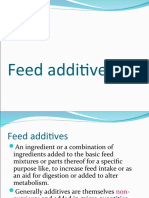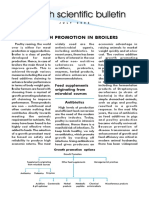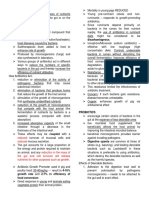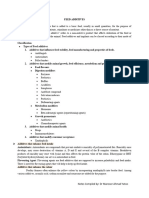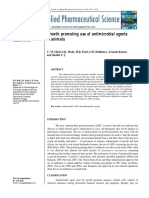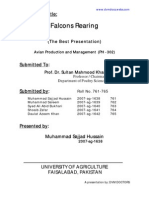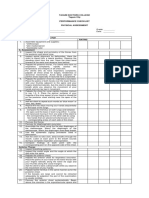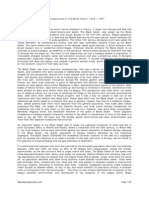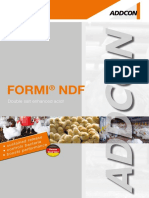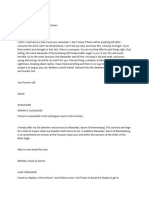0% found this document useful (0 votes)
23 views22 pagesFeed Additives
Animal Nutrition
Uploaded by
aivelhaksubdkaljsudbeineneklsCopyright
© © All Rights Reserved
We take content rights seriously. If you suspect this is your content, claim it here.
Available Formats
Download as PDF, TXT or read online on Scribd
0% found this document useful (0 votes)
23 views22 pagesFeed Additives
Animal Nutrition
Uploaded by
aivelhaksubdkaljsudbeineneklsCopyright
© © All Rights Reserved
We take content rights seriously. If you suspect this is your content, claim it here.
Available Formats
Download as PDF, TXT or read online on Scribd
/ 22
Feed Additives
Prepared by: Dr. Alyssa Marie Garcia
Why Use Feed Additives in Animal Diets?
Feed additives are supplemental ingredients included in
animal diets in small quantities.
Primary Goals:
• Enhance digestibility and availability of nutrients
bound in feed.
• Improve gut health to support optimal growth and
disease resistance.
• Increase product quality (e.g., nutrient content, color,
flavor) for human consumption.
• Prolong shelf life and prevent spoilage of feed
ingredients.
• Promote sustainability by reducing nutrient waste (e.g.,
phosphorus, nitrogen) and environmental pollution.
Common Examples
I. Enzymes - improve nutrient release and reduce
antinutritional effects.
II. Probiotics/Prebiotics -support a balanced gut microbiota.
III. Antioxidants - prevent rancidity and preserve feed quality.
IV.Antibiotic Growth Promoters (AGPs) - enhance animal
performance and control disease.
V. Specialized additives - mold inhibitors, mycotoxin binders,
coloring agents, coccidiostats, and pellet binders.
VI.Anabolic feed additives
I. Enzymes
• They address antinutritional
factors, especially in plant-
based feeds for monogastric
animals.
➢ Monogastric animals
(e.g., pigs, poultry) lack
the ability to digest
certain compounds like
phytate and non-starch
polysaccharides (NSPs).
I. Enzymes
Phytate (Phytic acid):
• Major phosphorus storage form in seeds; accounts for 50–80% of
total phosphorus in plant seeds.
• Binds phosphorus, calcium, and amino acids, making them unavailable
for digestion.
Microbial Phytase:
• Breaks down phytate into digestible phosphorus.
• Reduces reliance on inorganic phosphorus supplements.
• Improves nutrient absorption and reduces phosphorus excretion into
the environment.
I. Enzymes
Factors Affecting Efficacy:
• Feed: Solubility of phytate,
enzyme source, and feed
particle size.
• Animal: Gut pH, feed retention
time in the gastrointestinal
tract.
I. Enzymes
Non-Starch Polysaccharides (NSPs):
• Found in grains like rye, wheat, barley, and oats.
• Increase feed viscosity, slow digestion, and create favorable conditions
for harmful bacteria.
Carbohydrate-Degrading Enzymes:
• Break down NSPs to smaller, digestible components, enhancing
energy availability and reducing antinutritive effects.
• Examples: Xylanase (targets arabinoxylans), β-glucanase (acts on β-
glucans), and cellulase.
• Future Challenges: Develop enzymes that efficiently target both
soluble and insoluble NSPs.
II. Probiotics and Prebiotics
Probiotics
They are live microorganisms that promote a healthy gut microbiota.
Benefits:
• Inhibit harmful pathogens via competitive exclusion and production of
bacteriocins or organic acids.
• Reduce the incidence of gastrointestinal issues (e.g., post-weaning diarrhea in
piglets).
• Enhance digestion and immunity, leading to improved growth and
productivity.
Examples:
• Bacterial: Lactobacillus, Bifidobacterium, Bacillus, and Enterococcus species.
• Non-Bacterial: Yeasts (Saccharomyces, Candida) and fungi (Aspergillus
oryzae).
II. Probiotics and Prebiotics
Prebiotics
Nondigestible ingredients that selectively stimulate beneficial gut microbes.
Examples:
• Disaccharides, oligosaccharides, and polysaccharides (e.g., inulin, mannan-
oligosaccharides, fructooligosaccharides).
Symbiotics:
• Combination of probiotics and prebiotics.
• Enhances the survival and implantation of beneficial microbes in the
gastrointestinal tract.
III. Antioxidants
• Prevent oxidation of feed
components, particularly fats, which
can result in:
➢ Rancidity.
➢ Destruction of essential
nutrients (e.g., vitamins A, D, E,
and amino acids).
➢ Reduced energy values and
feed quality.
• Increase the shelf life of feed and
ensure long-term nutritional stability.
III. Antioxidants
Types:
1. Natural Antioxidants
• Tocopherols (e.g., natural vitamin E).
• Plant extracts (e.g., rosemary, essential oils).
2. Synthetic Antioxidants
• Ethoxyquin, butylhydroxytoluene (BHT), and butylhydroxyanisole
(BHA).
**Comparative Efficacy
• Ethoxyquin is the most effective, followed by BHT and BHA.
IV. Antibiotic Growth Promoters (AGPs)
• Low-dose antibiotics used in animal feeds to enhance
growth and performance.
• AGPs can control subclinical infections and reduce
disease incidence.
• It improves feed conversion efficiency and animal
productivity.
• There are concerns about the development of antibiotic-
resistant bacteria, posing risks to human and animal
health and environmental contamination through
animal waste.
Historical context:
• First observed in the 1940s with tetracycline fermentation
byproducts.
• Expanded use with the rise of intensive livestock farming.
IV. Antibiotic Growth Promoters (AGPs)
Global Regulations:
• EU: Complete ban on
nontherapeutic AGPs.
• US: Regulated use; voluntary
withdrawal of nontherapeutic AGPs
by many manufacturers.
• Other countries maintain regulated
but limited usage.
IV. Antibiotic Growth Promoters (AGPs)
Current Regulation of AGPs in the
Philippines:
Administrative Order No. 42 (2014):
• Established an inter-agency committee to
create and implement a national plan to
combat antimicrobial resistance (AMR).
• Recognized AMR as a critical threat to
human and animal health.
IV. Antibiotic Growth Promoters (AGPs)
Current Regulation of AGPs in the Philippines:
Philippine Action Plan to Combat Antimicrobial
Resistance (2019-2023):
• Emphasizes a "One Health" approach to address
AMR across human, animal, and environmental
sectors.
• Promotes the prudent use of antimicrobials in
agriculture, including stricter regulations on AGPs in
animal feeds.
• The action plan aligns with international standards
and efforts, such as those advocated by the World
Health Organization (WHO) and the Food and
Agriculture Organization (FAO), to mitigate AMR.
IV. Antibiotic Growth Promoters (AGPs)
Current Regulation of AGPs in the
Philippines:
• While there is no explicit law exclusively
targeting AGPs, existing AMR-related
policies broadly regulate and monitor their
use.
• It focuses on ensuring public health safety
and sustainable agricultural practices.
• Its key objective is to reduce reliance on
AGPs in livestock production while
preventing the spread of AMR to humans
and the environment.
V. Other feed additives
Pigmenters:
• Natural (e.g., lutein, zeaxanthin) or synthetic (e.g., carophyll).
• Enhance color of animal-derived products (e.g., egg yolks, broiler
skin).
Mold Inhibitors:
• Organic acids used to prevent fungal growth and spoilage.
Mycotoxin Binders:
• Bind and neutralize mycotoxins (e.g., aflatoxins) to prevent
absorption and toxicity.
V. Other feed additives
Coccidiostats:
• Prevent coccidiosis, a protozoal
disease common in poultry.
Pellet Binders:
• Improve feed handling by
reducing dust and ensuring pellet
integrity.
VI. Anabolic Feed Additives
They enhance lean growth, improve nutrient utilization, and increase feed
efficiency. However, there are potential environmental contamination and
ethical issues regarding animal welfare.
Examples:
• β-Agonists (e.g., ractopamine) - promote muscle growth and reduce fat
deposition.
• Recombinant Bovine Somatotropin (rBST) - boosts milk production in
dairy cows.
• Anabolic Steroids - enhance muscle protein accretion and lean growth.
Global Use:
• EU: Banned anabolic feed additives.
• US: Limited approvals (e.g., melengestrol acetate for feedlot heifers,
ractopamine for swine).
Environmental and Ethical
Considerations
Antibiotics and anabolic additives:
• May enter the environment via excreta, impacting aquatic
ecosystems and soil microbiota.
Sustainability:
• Feed additives like enzymes and probiotics can reduce
nutrient waste, promote efficient feed use, and minimize
environmental footprints.
Ethics
• Increasing focus on alternatives to AGPs to balance animal
health and productivity with public health concerns.
END


